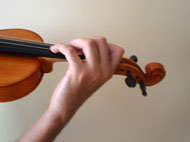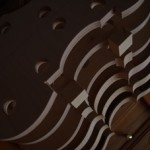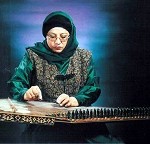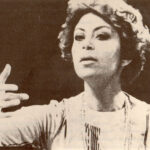
5.1.3.Points on playing chromatic scales
1.5.1.3.sometimes, a player, due to different reasons, may decisively want to play continuously two notes with a half-step by means of the same finger, in such a case, it’s necessary to open the interior curve of the finger like a spring. Naturally coming back, the curve of finger should be closed and the finger should become curved shape again (see paragraph 3.1.2.1).
Just like playing Fa-natural immediately after playing Mi-natural by forth finger, at Do major scale and first position of the second string.
2.5.1.3. Considering the way of playing this scale and using the same finger continuously for playing interval, beware not to apply extra vertical force on fingerboard by your fingers.
Because, the more is the applied force on the fingerboard by fingers, the more difficult it would be to open or close the interior curve of fingers and consequently the performance speed would decrease.
In such a case, in order to play the interval, the player inevitably needs to move her hand’s position forward or backward, and the role of finger gets weaker.
3.5.1.3. When changing the position or shape of finger for playing the interval of chromatic scales, player should avoid changing the position of left thumb.
Also playing the chromatic scale, sometimes the player may mistakenly flex the part of palm that is joined thumb. The player should avoid such a flex that may cause her feel cramps in her hand.
4.5.1.3. Since playing chromatic step always involves shifting fingers, it is necessary to be careful about playing the exact tempo (see notification 15).
Pattern number 4/1
Playing the doubles
There are some points that must be considered when playing doubles of the notes. They must be practiced step by step so that you find mastery over these doubles.
1.1.4. The first point is to be skilled at bowing on two open strings simultaneously and creating harmonious and perfect sound with the instrument. Hence, the practice of playing the double of open strings can be performed for the independent right and left bows that are played thoroughly (from frog to point).
Here, acquiring dominance and skill at creating perfect and harmonious sound with bow is achieved by practicing in a slow tempo. (such as playing three Whole note play on open string doubles at tempo 60 Bpm during a whole bow length).
Notification 18: the technique of bowing for playing doubles by right hand and the direction of different parts of right hand to each other and to body will be discussed later in the section on the techniques of right hand. Here, from now on, we only discuss the points related to left hand.
2.1.4. The next point is to find mastery over playing a double involving a finger and the neighboring open string. In fact, this is at this state that left hand makes its first attempt at playing the double.
To do this, the player should place each of the fingers at different distances from the nut(for playing different intervals) and practice double finger placing with the neighboring open string. It should be mentioned that here it is also needed to practice at slow tempo and with separate bows for each double.

Fourth finger at its natural state and with curved shape

Forth finger with opened curve and being straightened for











